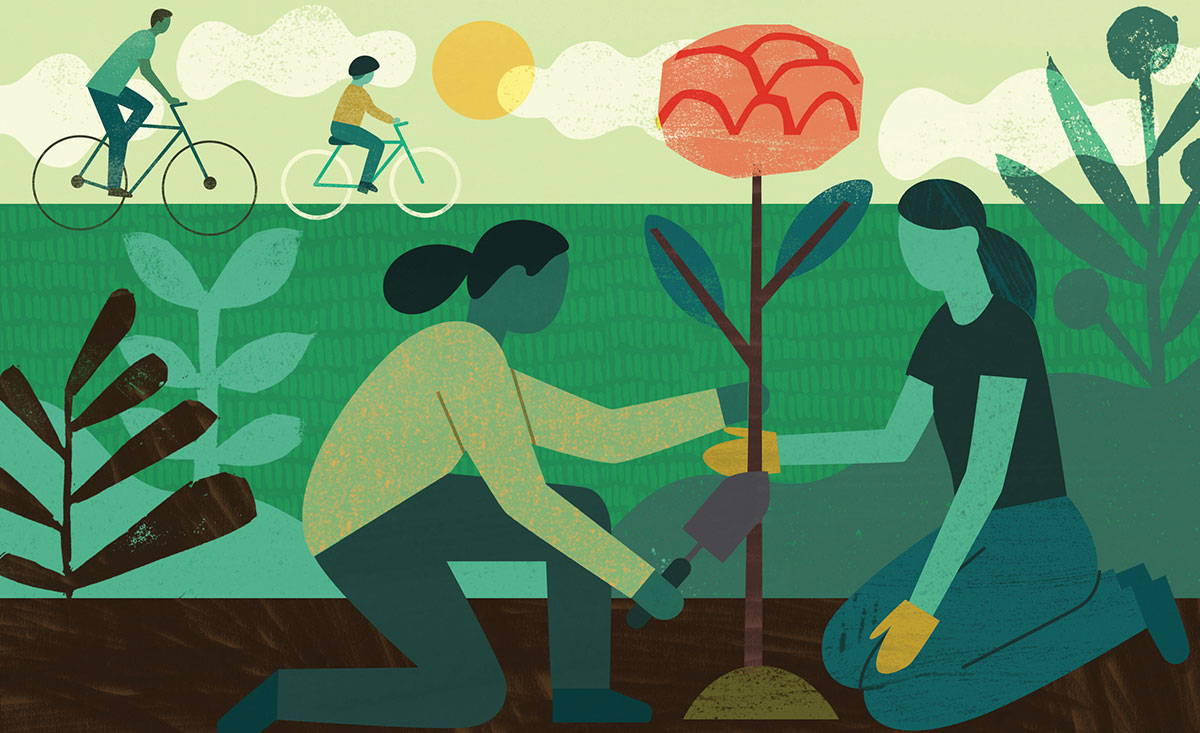Game-changing research often results when strong personal motivation meets an urgent problem in need of a solution. In the Honors College at UT Arlington, undergraduate researchers spend their semesters digging deep into their chosen disciplines, often conducting research alongside faculty mentors. At the end of their UTA journeys, Honors students embark on a Capstone project, a creative work or research investigation demonstrating the culmination of their undergraduate education.
A prized academic milestone in an Honors student’s journey, the Honors Capstone project completes the Honors degree. Signifying a great amount of research and organization of thought, the Honors Capstone demonstrates to graduate school admissions committees, scholarship review boards, and prospective employers that students have the intellectual maturity to pursue independent academic endeavors. All Honors students produce a deliverable and showcase their Capstone project at the Honors Research Symposium in either an oral and/or poster presentation.
“It’s so rewarding to witness students’ transformation from the discovery of research to the application of research methods to real-world problems,” says Bobbie Brown, assistant director of undergraduate research for the Honors College. “By the time they reach their capstone projects, the students have transitioned into tackling hard questions that have the potential to change lives.”
“It’s so rewarding to witness students’ transformation from the discovery of research to the application of research methods to real-world problems.”

Addressing Childhood Health
Data from the Centers for Disease Control and Prevention shows that childhood obesity affects approximately 14.7 million children and adolescents in the United States. Across income groups and household education levels, the risk of obesity varies. In addition to unbalanced diets and lack of physical activity, the community where a child grows up plays a major role in determining their weight, says Alexis Jones (’22 BS, Exercise Science).
“For example, lower-income families may not feel safe in their communities, and they won’t let their children play outside,” Jones says. “Inside play is usually limited due to lack of space, and outdoor play isn’t an option. The child’s opportunities for physical activity are extremely limited.”
In her capstone study of children ages 2 to 5 who were recruited from two childcare centers and one gymnasium in the North Texas area, Jones explored how social demographics such as ethnicity, race, and socioeconomic status correlate to physical activity and childhood obesity.
Under the supervision of Xiangli Gu, assistant professor of kinesiology, Jones measured the participants’ height, weight, and body mass index (BMI). Then, surveys completed by the children’s parents assessed their child’s home environment, built environment, and levels of physical activity and sedentary behavior.
In the first survey, parents responded to questions that assessed how their parenting style influenced their child’s level of physical activity and measured methods of transportation, safety concerns, and the availability of motor toys. Additional surveys asked the parents to describe their neighborhood infrastructure and how much time their child spent doing activities like watching TV, playing video games, riding a bicycle, or exercising outdoors.
Results illustrated that children whose families were of higher socioeconomic status engaged in more physical activity and less sedentary behavior per week than the children from lower-socioeconomic status families. Jones correlated that family income can affect a child’s physical activity, which can further impact their BMI.
“The evidence of environmental influence on childhood obesity can help child care professionals identify populations that are at risk and decrease the likelihood of future health complications,” she says. “Early intervention will be key to curbing the national obesity crisis.”
Cooling Heat Islands
While bustling cities are often epicenters of jobs, housing, health care, and other life-supporting resources, large urban landscapes can also produce harmful effects on their environments. Materials used for buildings, roadways, and other infrastructure absorb the sun’s heat and slowly release it, causing metropolitan temperatures to be warmer than surrounding rural areas. Concentrated cities become islands of heat, leading to increased energy consumption, pollution, and greenhouse gas emissions.

For his capstone, Raul-Andres Hassenteuffel Morales focused on the fight against climate change.
Higher temperatures also contribute to human illnesses such as respiratory difficulties, heat exhaustion, and stroke, while heat trapped in pavement and rooftops increases the temperature of stormwater runoff, which affects the metabolism and reproduction of aquatic life in streams, rivers, ponds, and nearby lakes.
Research conducted by Raul-Andres Hassenteuffel Morales (’22 BA, Architecture) considers how green roof garden systems could mitigate the harmful effects of these heat islands.
“Buildings and infrastructure contribute to many harmful processes that accelerate climate change,” Morales says. “It is important for architects to approach building design in a manner that respects and responds to nature, rather than one that works against it.”
In a review of green roof literature, he found numerous benefits, including lower heat transfer, decreases in surface temperatures by up to 80 degrees, additional building insulation resulting in lower energy consumption, and significant rainwater absorption.
To combat heat intensity, Morales proposed the retrofitting of city rooftops to host green spaces. Citing a study of the buildings in downtown Toronto, he argued that widespread rooftop renovations could reduce citywide temperatures. If governments work together to achieve this goal, it could even impact global temperatures, Morales says.
In a case study supervised by Kathryn Holliday, professor of architecture, Morales provided an evidence-based approach to a rooftop garden design for the main building of UTA’s College of Architecture, Planning, and Public Affairs. His design recommended a mixed-use layout, including a garden and hard-surface area for potential classroom activities. He advised planners to incorporate native plants into garden design, acknowledging their benefits to insect life and visitor enjoyment.
Although the cost of adding green roof garden systems is more expensive than conventional roofing, the perks of green spaces greatly outweigh the costs, Morales says.
“Small changes such as the addition of rooftop gardens can provide invaluable long-term benefits to residents and the environment,” he says. “One small step at a time, we can solve the climate crisis.”
Decreasing Stigma
When Christine Abasi (’22 BA, Communication; BS, Psychology) developed a stutter at the age of 10, her classmates’ mockery discouraged her from lessons with her speech therapist. It wasn’t until two years later that she had gained enough confidence to fully commit to the therapeutic techniques that eventually helped her manage the disorder. Years later, as an undergraduate researcher at UTA, she was determined to use her experience to help others.

Prompted by a class assignment, Abasi conducted a literature review of published research on the topic of stuttering. She didn’t find as much information as she had hoped.
Crediting support from her faculty advisor Molly Cummins, lecturer of communication, Abasi decided to lend her voice to the body of research addressing the deeply personal topic. Her investigation earned her an invitation to Texas Undergraduate Research Day, where she educated an audience of Texas legislators and members of the public about possible causes and treatments of persistant stuttering disorder.
Although stuttering has been a medically recognized speech disorder since the 1960s, people who stutter are often subjected to negative public perceptions, Abasi says.
“The stigma around stuttering is perpetrated in many ways, including mass media, cultural beliefs, and misinformation,” she says. “There has been and continues to be a strong connection between stuttering in mainstream media and negative characteristics such as lack of intelligence, nervousness, or lack of social skills.”
Those negative perceptions can have adverse effects on mental and physical health. Research shows that internalization of negative attitudes by people who stutter is linked to higher anxiety, depression, lower self-esteem, and even gastrointestinal issues.
To address the problem, Abasi investigated the source of negative social stigma and possible methods to reduce it. In a survey of males and females aged 19 to 60, she quizzed participants on their perceptions of stuttering before and after an interpersonal and educational intervention.
“The combination of my personal history and the knowledge I have gained at UTA gives me a unique view of how both the public and researchers approach the stigma surrounding stuttering.”

Christine Abasi’s capstone project had a personal motivation.
Participants watched a 10-minute video produced by CBS in 2011 titled Finding Their Voices—Understanding Stuttering, which explains what stuttering is and addresses some of the most common stuttering misconceptions.
The study found that the intervention significantly improved social attitudes on the topic. After watching the video, participants reported higher levels of empathy with people who stutter and that they would be less likely to fill in words or make jokes during a conversation when someone stutters.
In graduate school for speech pathology, Abasi plans to examine how public education and interpersonal communication between those who stutter and the people in their lives can influence how communities respond to those with speech disorders. As a speech pathologist, she hopes to identify effective ways to increase the quality of life for people who stutter by decreasing adverse emotional effects that result from the disorder.
“The combination of my personal history and the knowledge I have gained at UTA, especially through my work in the Honors College, gives me a unique view of how both the public and researchers approach the stigma surrounding stuttering,” Abasi says. “I’ve seen both sides of the coin. Now I can apply that knowledge to help others overcome the social challenges that accompany stuttering.” UTA







